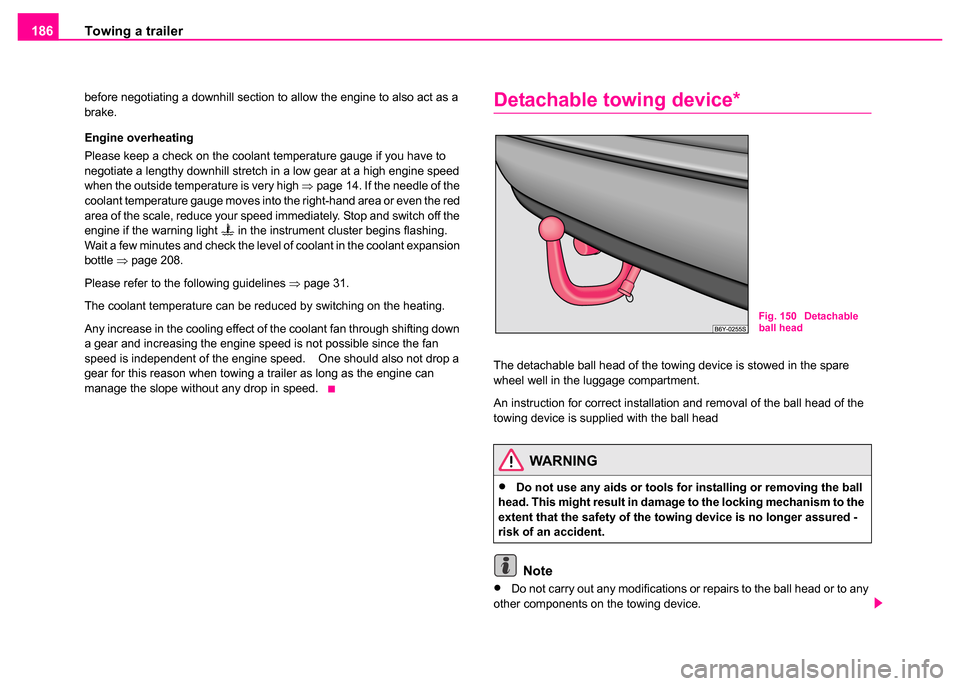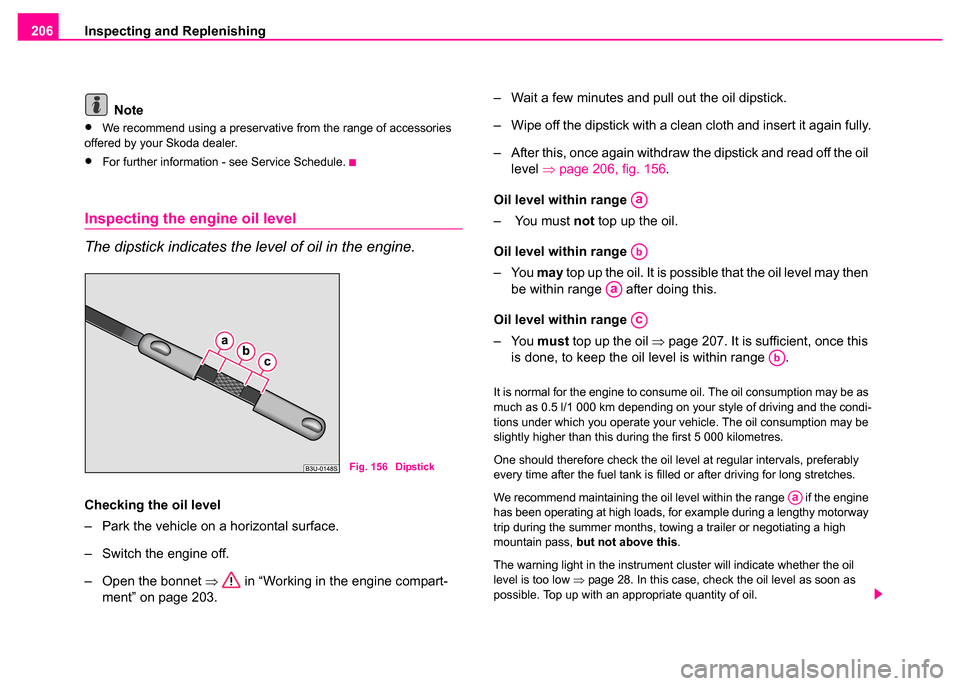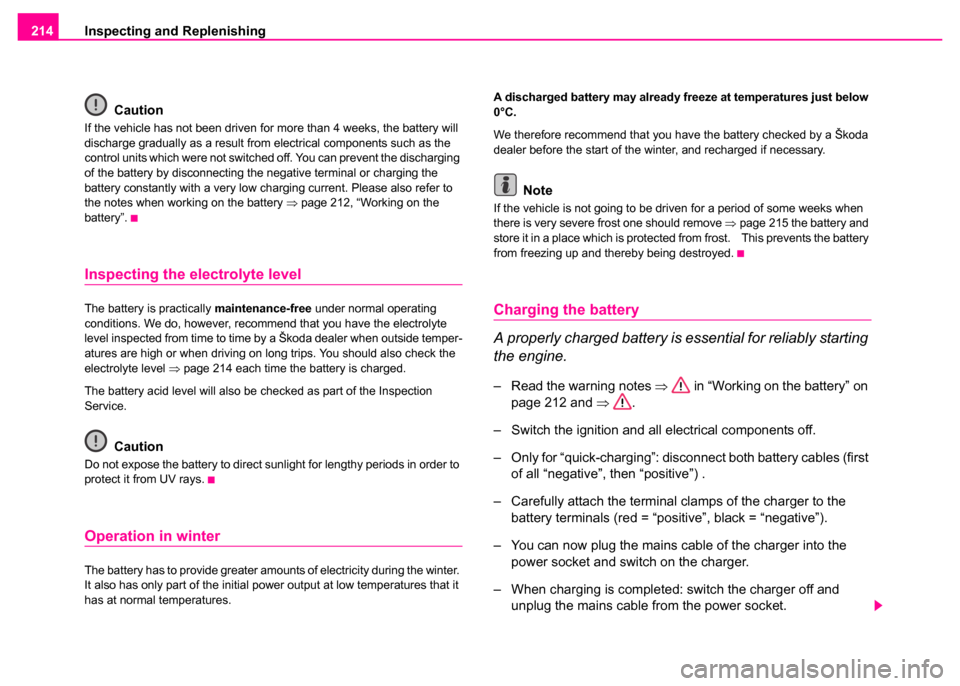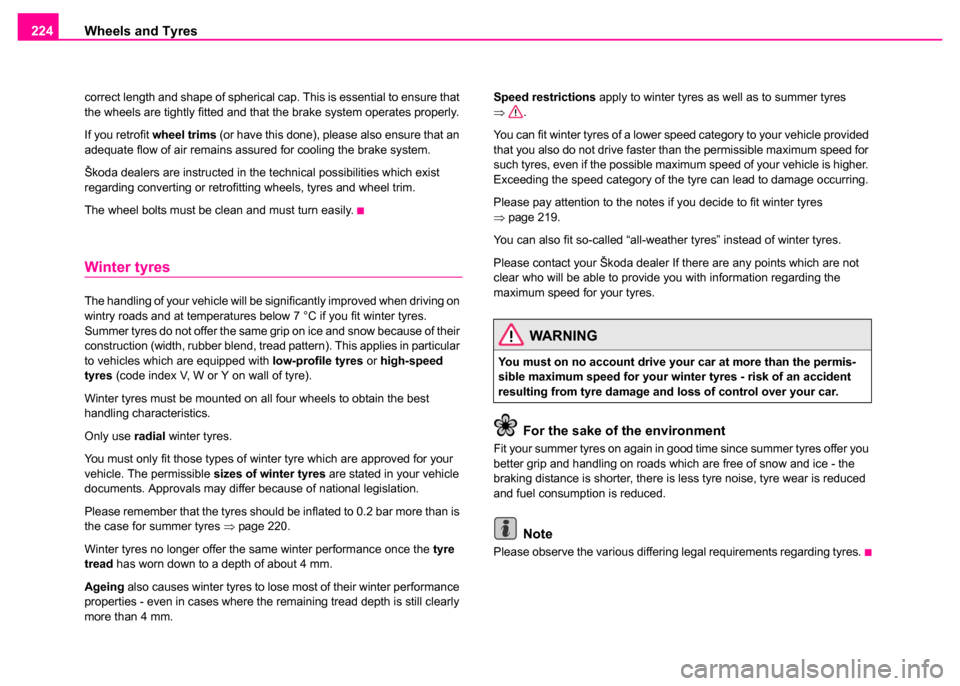length SKODA SUPERB 2003 1.G / (B5/3U) User Guide
[x] Cancel search | Manufacturer: SKODA, Model Year: 2003, Model line: SUPERB, Model: SKODA SUPERB 2003 1.G / (B5/3U)Pages: 259
Page 187 of 259

Towing a trailer
186
before negotiating a downhill section to allow the engine to also act as a
brake.
Engine overheating
Please keep a check on the coolant temperature gauge if you have to
negotiate a lengthy downhill stretch in a low gear at a high engine speed
when the outside temperature is very high ⇒page 14. If the needle of the
coolant temperature gauge moves into the right-hand area or even the red
area of the scale, reduce your speed immediately. Stop and switch off the
engine if the warning light
in the instrument cluster begins flashing.
Wait a few minutes and check the level of coolant in the coolant expansion
bottle ⇒page 208.
Please refer to the following guidelines ⇒page 31.
The coolant temperature can be reduced by switching on the heating.
Any increase in the cooling effect of the coolant fan through shifting down
a gear and increasing the engine speed is not possible since the fan
speed is independent of the engine speed. One should also not drop a
gear for this reason when towing a trailer as long as the engine can
manage the slope without any drop in speed.
Detachable towing device*
The detachable ball head of the towing device is stowed in the spare
wheel well in the luggage compartment.
An instruction for correct installation and removal of the ball head of the
towing device is supplied with the ball head
Note
•Do not carry out any modifications or repairs to the ball head or to any
other components on the towing device.
WARNING
•Do not use any aids or tools for installing or removing the ball
head. This might result in damage to the locking mechanism to the
extent that the safety of the towing device is no longer assured -
risk of an accident.
Fig. 150 Detachable
ball head
Page 196 of 259

Care and cleaning195
Using the systemSafetyDriving TipsGeneral MaintenanceBreakdown assistanceTechnical Data
Leather cleaning and care
In view of the exclusiveness of the qualities and characteristics of the
leathers used (such as sensitivity to oils, greases, dirt etc.) a certain care-
fulness in use and particular care are required. Dark items of clothing, for
example, (particularly if these are moist and have poor quality dyeing)
may colour the leather seats. Dust and dirt particles in pores, creases and
seams may chafe and damage the surface. For this reason, care for the
leather regularly, or according to the wear-and-tear. After a lengthy period
of use, your leather seats will acquire a typical and unique patina. This is
characteristic of the natural product leather and is a sign of genuine
quality.
Please pay attention to the following notes in order to retain the value of
the natural material over its full life:
Caution
•Avoid leaving your vehicle for lengthy periods in bright sunlight in order
to avoid bleaching the leather. If you leave your vehicle parked in the open
for lengthy periods, protect the leather from the direct rays of the sun by
covering it over.
•Sharp-edged objects on items of clothing such as zip fasteners, rivets,
sharp-edged belts may leave permanent scratches or signs of rubbing on
the surface.
Note
•Use a care cream with light blocker and impregnation effect regularly
and each time after cleaning the leather. The cream nourishes the leather,
allows it to breathe and keeps it supple and also provides moisture. It also
creates surface protection.
•Clean the leather every 2 to 3 months, remove fresh soiling each time
this occurs.
•Remove fresh stains such as those from ball-point pens, ink, lipstick,
shoe cream etc., as quickly as possible.
•Care also for the leather dye. Refreshen areas which have lost their
colour with a special coloured leather cream as required.
Cleaning and care of leather upholstery
Normal cleaning
– Clean soiled areas of the leather with slightly moistened
cotton or woollen cloth.
Severe soiling
– Clean severely soiled areas with a cloth dipped in a mild soapy solution (2 spoonfuls of natural soap to 1 litre of water).
– Ensure that the leather is not soaked through at any point and that no water gets into the stitching of the seams.
– Dry off the leather with a soft, dry cloth.
Removing stains
– Remove fresh stains which are water-based (e.g. coffee, tea,
juices, blood etc.) with an absorbent cloth or household paper
or use the cleaner from the care set for a stain which has
already dried in.
– Remove fresh stains which are oil based (e.g. butter, mayon-
naise, chocolate etc.) with an absorbent cloth or household
cleaning paper or with the cleaner from the care set if the stain
has not yet penetrated into the surface.
– Use a grease dissolver for grease stains which have dried
in .
Page 207 of 259

Inspecting and Replenishing
206
Note
•We recommend using a preservative from the range of accessories
offered by your Skoda dealer.
•For further information - see Service Schedule.
Inspecting the engine oil level
The dipstick indicates the level of oil in the engine.
Checking the oil level
– Park the vehicle on a horizontal surface.
– Switch the engine off.
– Open the bonnet ⇒ in “Working in the engine compart-
ment” on page 203. – Wait a few minutes and pull out the oil dipstick.
– Wipe off the dipstick with a clean cloth and insert it again fully.
– After this, once again withdraw the dipstick and read off the oil
level ⇒page 206, fig. 156 .
Oil level within range
– You must not top up the oil.
Oil level within range
–You may top up the oil. It is possible that the oil level may then
be within range after doing this.
Oil level within range
–You must top up the oil ⇒page 207. It is sufficient, once this
is done, to keep the oil level is within range .
It is normal for the engine to consume oil. The oil consumption may be as
much as 0.5 l/1 000 km depending on your style of driving and the condi-
tions under which you operate your vehicle. The oil consumption may be
slightly higher than this during the first 5 000 kilometres.
One should therefore check the oil level at regular intervals, preferably
every time after the fuel tank is filled or after driving for long stretches.
We recommend maintaining the oil level within the range if the engine
has been operating at high loads, for example during a lengthy motorway
trip during the summer months, towing a trailer or negotiating a high
mountain pass, but not above this .
The warning light in the instrument cluster will indicate whether the oil
level is too low ⇒page 28. In this case, check the oil level as soon as
possible. Top up with an appropriate quantity of oil.
Fig. 156 Dipstick
Aa
Ab
Aa
Ac
Ab
Aa
Page 215 of 259

Inspecting and Replenishing
214
Caution
If the vehicle has not been driven for more than 4 weeks, the battery will
discharge gradually as a result from electrical components such as the
control units which were not switched off. You can prevent the discharging
of the battery by disconnecting the negative terminal or charging the
battery constantly with a very low charging current. Please also refer to
the notes when working on the battery ⇒page 212, “Working on the
battery”.
Inspecting the electrolyte level
The battery is practically maintenance-free under normal operating
conditions. We do, however, recommend that you have the electrolyte
level inspected from time to time by a Škoda dealer when outside temper-
atures are high or when driving on long trips. You should also check the
electrolyte level ⇒page 214 each time the battery is charged.
The battery acid level will also be checked as part of the Inspection
Service.
Caution
Do not expose the battery to direct sunlight for lengthy periods in order to
protect it from UV rays.
Operation in winter
The battery has to provide greater amounts of electricity during the winter.
It also has only part of the initial power output at low temperatures that it
has at normal temperatures. A discharged battery may already freeze at temperatures just below
0°C.
We therefore recommend that you have the battery checked by a Škoda
dealer before the start of the winter, and recharged if necessary.
Note
If the vehicle is not going to be driven for a period of some weeks when
there is very severe frost one should remove
⇒page 215 the battery and
store it in a place which is protected from frost. This prevents the battery
from freezing up and thereby being destroyed.
Charging the battery
A properly charged battery is essential for reliably starting
the engine.
– Read the warning notes ⇒ in “Working on the battery” on
page 212 and ⇒.
– Switch the ignition and all electrical components off.
– Only for “quick-charging”: disconnect both battery cables (first of all “negative”, then “positive”) .
– Carefully attach the terminal clamps of the charger to the battery terminals (red = “positive”, black = “negative”).
– You can now plug the mains cable of the charger into the power socket and switch on the charger.
– When charging is completed: switch the charger off and unplug the mains cable from the power socket.
Page 225 of 259

Wheels and Tyres
224
correct length and shape of spherical cap. This is essential to ensure that
the wheels are tightly fitted and that the brake system operates properly.
If you retrofit wheel trims (or have this done), please also ensure that an
adequate flow of air remains assured for cooling the brake system.
Škoda dealers are instructed in the technical possibilities which exist
regarding converting or retrofitting wheels, tyres and wheel trim.
The wheel bolts must be clean and must turn easily.
Winter tyres
The handling of your vehicle will be significantly improved when driving on
wintry roads and at temperatures below 7 °C if you fit winter tyres.
Summer tyres do not offer the same grip on ice and snow because of their
construction (width, rubber blend, tread pattern). This applies in particular
to vehicles which are equipped with low-profile tyres or high-speed
tyres (code index V, W or Y on wall of tyre).
Winter tyres must be mounted on all four wheels to obtain the best
handling characteristics.
Only use radial winter tyres.
You must only fit those types of winter tyre which are approved for your
vehicle. The permissible sizes of winter tyres are stated in your vehicle
documents. Approvals may differ because of national legislation.
Please remember that the tyres should be inflated to 0.2 bar more than is
the case for summer tyres ⇒page 220.
Winter tyres no longer offer the same winter performance once the tyre
tread has worn down to a depth of about 4 mm.
Ageing also causes winter tyres to lose most of their winter performance
properties - even in cases where the remaining tread depth is still clearly
more than 4 mm. Speed restrictions
apply to winter tyres as well as to summer tyres
⇒ .
You can fit winter tyres of a lower speed category to your vehicle provided
that you also do not drive faster than the permissible maximum speed for
such tyres, even if the possible maximum speed of your vehicle is higher.
Exceeding the speed category of the tyre can lead to damage occurring.
Please pay attention to the notes if you decide to fit winter tyres
⇒ page 219.
You can also fit so-called “all-weather tyres” instead of winter tyres.
Please contact your Škoda dealer If there are any points which are not
clear who will be able to provide you with information regarding the
maximum speed fo r your tyres.
For the sake of the environment
Fit your summer tyres on again in good time since summer tyres offer you
better grip and handling on roads which are free of snow and ice - the
braking distance is shorter, there is less tyre noise, tyre wear is reduced
and fuel consumption is reduced.
Note
Please observe the various differing legal requirements regarding tyres.
WARNING
You must on no account drive your car at more than the permis-
sible maximum speed for your winter tyres - risk of an accident
resulting from tyre damage and loss of control over your car.